Pharm Exec's 10th Annual Industry Audit
Bill Trombetta surveys the landscape of pharma financials over the past year, and shows which companies rode the wave to the top of the industry in delivering value to shareholders.
In the midst of a late summer economic chill, Pharm Exec's 10th Annual Pharma Industry Audit looks at the balance sheets to find who leads and lags in the push to execute the harsh medicine of Spartan-like cost discipline. Prepared by Professor Bill Trombetta of the Erivan K. Haub School of Business at St. Joseph's University, our diagnosis seems to follow the first clause of a long-standing health maxim: starve a cold. Those companies who managed to increase value for shareholders while keeping costs down at the same time—even better without the challenges associated with a big acquisition—received top honors from Trombetta this year.

Getty images: Hiroshi Watanabe
Top-line measures like Enterprise Value growth, foretelling stock trajectory, and Profit to Sales provide a clear assessment of financial health, but the under-the-radar Sales, General and Administrative (SG&A) Expenses to Sales measure uncovers total overhead against sales income, getting to that all important ability to lower administrative costs, without harming sales performance. Surprisingly, sales and marketing represent a relatively low portion of SG&A, which includes day-to-day expenses such as legal and accounting fees, utilities, and rent. Average SG&A spend, measured against sales income, was 30.4 percent in 2010, up from 28.1 percent in 2009. While companies spent a little more on average, sales went up 11 percent, and SG&A spend increased by 8.2 percent—overall, companies have been able to reduce overhead, a sign that industry is adapting successfully to new cost pressures.
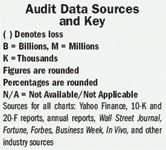
Audit Data Sources and Key
Biogen Idec and Gilead are two notable examples on the low end of the SG&A Expenses to Sales measure; both companies spent relatively less on marketing and promotion. The calculations are prescient: Moody's raised Biogen Idec's outlook in mid-August of this year, citing a strong operating performance and cost reductions like consolidated facilities, and a narrowed focus on multiple sclerosis; 75 percent of the company's revenues now come from the MS category. Biogen Idec grew Tysabri's worldwide sales by 31 percent ($389 million) in the second quarter of 2011, compared with 2Q 2010.
Gilead made a strategic decision in 2010 to close its R&D operations in Durham, N.C., choosing to consolidate R&D work on hepatitis B and C in Foster City, Calif. That move wiped over 100 employees off the books and consolidated operations—and overhead costs—on the West Coast. While the Industry Audit doesn't weigh SG&A Expenses to Sales as a factor for determining winners, it's a statistic worth considering. Companies looking to increase margins on top of a large sales base will have to look at all costs, not just sales forces and promotional spend, to locate efficiencies and react to unforeseen regulatory events and external price controls.
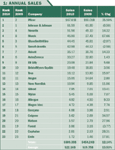
1: Annual Sales
The average Enterprise Value to Sales, the top weighted measure assessing sales growth and earnings growth for shareholders, was at a dismal 3.18 for 2010, down from 3.24 in 2009. Investors eying an Enterprise Value to Sales ratio in the low threes would be advised to pick up hamburger and soda stocks as an alternative: McDonald's and Coca-Cola had a better performance last year. However, this year's Audit winner—diabetes giant Novo Nordisk—sported a ratio of 6.27, second only to Celgene's 7.39 Enterprise Value to Sales ratio. Ultimately, Novo posted a 33 percent increase in shareholder value, without a significant merger or acquisition, and increased its gross margin by more than 7 percent, from 2009 to 2010. If diabetes rates continue to grow worldwide, as the World Health Organization has forecasted they will, Novo is uniquely positioned to capture sales overseas, and to benefit from next-generation synthetic insulin products like Victoza (liraglutide). Company execs have said the drug will reach blockbuster status by this year's end. If companies can starve a cold, without giving into a "feed a fever" return to excess operational costs on new, big-selling, innovative drugs, they'll be able to continue providing profit margins—and value for stakeholders—at a rate in keeping with the most lucrative industries in the world.

2: Enterprise Value
The Word on Methodology
This year's Audit assesses the performance of the top 23 publicly traded drug companies (by sales revenue). We assess 2010 performance against 2009, which was a good year for stocks due to the economic trough relatively receding in 2008.

3: Enterprise Value to Sales
Post mega-mergers, the industry now seems to be stuck in neutral, as major drugs are going off patent with little to replace the blockbusters. Rather than persuing a clear new strategic direction, pharma seems to be reacting defensively by pursuing emerging markets, narrow target segments focused on high unmet medical needs, and, as always, mergers and acquisitions.
Benchmarking the Eight
As in years past, we use eight metrics to assess industry performance: Enterprise Value growth; the ratio of Enterprise Value to Sales; Profit to Assets; Gross Margin; Profit to Sales; Sales to Assets; Sales to Employees; and Sales Growth. The first three metrics are more important than the remaining five and are weighted by a factor of 5, with the remaining five metrics weighted by a factor of 3. Each company is assessed on each metric, from the highest placement (23 out of 23 companies) to the lowest placement (one out of 23). Each metric is multiplied by its weight times placement to determine points over the ranking. Each company's total points score is determined by adding up all points per placement times weighting, then ranking the 23 companies with the best performance at the highest point total to uncover this year's winning company.

4: Gross Margin
Benchmark: It is interesting to compare the drug industry with macro benchmarks and other healthcare sectors. In terms of share value growth these are the benchmark metrics:
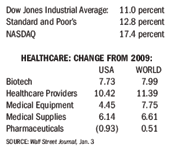
Hence, our 23 companies, with enterprise value growth averaging 9.6 percent, are surpassed only by Healthcare Providers.
Sales Rank: Table 1 simply ranks from top to bottom our 23 companies in terms of total sales revenues.
Sales Growth: Table 1 also shows which companies grew sales revenue more than others. Growth is a critical metric: Grow or you're sunk. You can only cut costs to grow profits for so long. Eventually, sales need to grow. But what kind of growth? The most qualitative growth is organic: sales that come from the company in-house. Mergers and acquisitions will always be a growth avenue, but the market recognizes that this kind of growth is not as desirable as organic growth. As Procter & Gamble CEO Bob McDonald puts it: "It's my ... responsibility to figure out how to get our growth goals without an acquisition," as reported recently in Business Week.
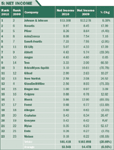
5: Net Income
Pfizer and particularly Merck exhibited substantial growth in 2010, but this was due mainly to the post-merger integration of Wyeth and Schering-Plough businesses, respectively. Other avenues to growth can come from price increases. Gilead and Celgene are examples of the latter route to growth.
The average sales growth of our lineup for the period 2010 – 2009 was 22.1 percent. A handful of companies did not grow sales: Johnson & Johnson, GlaxoSmithKline, Sanofi-Aventis, and Forest. Clearly, Johnson & Johnson had a difficult year, with manufacturing problems, OTC recalls, lawsuits, and regulatory attention directed to its medical devices strategic business unit. Notwithstanding these travails, Johnson & Johnson still managed to rank as the 17th most admired corporation in Fortune's annual Most Admired Corporations survey (March 2011).
Given the ability to merge and acquire, the strength of this metric is tempered by a weight of three.
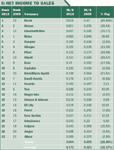
6: Net Income to Sales
Enterprise Value: Enterprise Value is a firm's market capitalization (total shares of common stock outstanding times the price of the stock on a given day) plus cash minus debt. Enterprise Value reflects the value of a firm in terms of what it would cost to buy it. Enterprise Value also reflects the future income of the company discounted to present value. The goal is to increase or create shareholder value versus what it would take to destroy shareholder value. This important metric merits a weight of five.
The higher the Enterprise Value, the more impressive the company is in delivering to shareholders. An increase in Enterprise Value is a sign that shareholder value is being created. But there is a link between size or scale of operations and Enterprise Value. There will be a correlation between sales volume and Enterprise Value.
This leads to our next critical metric: Growth in Enterprise Value. Average Enterprise Value growth for the top 23 companies was 9.6 percent. Substantial growth was seen by Pfizer, Novartis, Sanofi-Aventis, Novo Nordisk, Biogen-Idec, Allergan, and Endo. A substantial part of this growth was associated with anticipated mergers, raising stock prices.
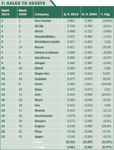
7: Sales to Assets
Enterprise Value to Sales (EV/S): As noted, the higher sales volume is, the higher absolute Enterprise Value tends to be. We need a ratio that normalizes or neutralizes the absolute size factor. That ratio is Enterprise Value to Sales. The higher the ratio, the implication is that sales growth and earnings growth will continue to rise. The lower the ratio, the implication is that a company will maintain steady, if not spectacular, sales as well as earnings growth. Celgene and Novo Nordisk lead the pack with ratios of 7.39 and 6.27, respectively. Novo Nordisk's EV/S increased whereas Celgene's decreased.
The average EV/S for our companies in 2010 is 3.18; in 2009 it was 3.24. The decrease suggests that our companies are facing strong headwinds relegating them to "value" stocks, with the exceptions noted. Better prospects can be found with hamburger, soda, and cigarette stocks such as McDonald's (4.05), tobacco company Altria (3.79), and Coca-Cola (4.50).
A large base isn't an excuse for diminished growth: Apple, for example, has a substantial sales base, but has still been able to demonstrate amazing growth. With revenues of $65 billion, the tech giant grew 60 percent last year, as reported Forbes magazine in March. With a market capitalization of $324 billion, this results in an approximate EV/S ratio of 5.0, indicating that Apple is just getting started.
Patent expiration cannot be gainsaid. Everyone knows how vulnerable many of the major pharmas are regarding key blockbuster drugs going off patent. This patent vulnerability takes its toll on the valuation of pharmaceutical companies. According to analysts at Bernstein Research and reported in The New York Times, Eli Lilly and AstraZeneca are most vulnerable, with GlaxoSmithKline, Novartis, and Bristol Myers-Squibb showing good prospects.
Gross Margin: Gross Margin reflects pricing power, and represents the difference between sales revenue and cost of goods sold on the profit and loss statement or income statement. The greater the difference, the more money is left to cover operating costs and contribute to profit before taxes. Biogen-Idec and Celgene set a nosebleed pace with price markups over 91 percent. That is, for every $1 in revenues, only 9 cents goes to the cost of the physical ingredient making up the drug. Average Gross Margin for 2010 for our lineup is: 72.1 percent. This indicates that (branded) pharma is a high-price sector. The key to Gross Margin is to be able to maintain its reflecting pricing power. Increasing Gross Margin is good, but if you are at the stratospheric levels of Biogen-Idec or Celgene you are bumping up against infinity.
Still Spinning Profit
Net Profit (EBITDA) to Sales: This ratio is the profit margin. It shows what is left after subtracting cost of goods sold and operating expenses from sales revenue off the profit and loss statement. Again, the higher it is, the better a firm's performance. The average profit margin in 2010 was: 17.2 percent, reflecting the fact that the drug industry is still one of the most profitable industries in the world, at the levels of investment banking and energy.
Sales to Assets: This is an under-the-radar metric. It reflects how well a firm manages its assets. Companies are in business to use assets—not simply own assets—productively and efficiently. The average Sales to Assets ratio for 2010 was 0.533. This means that every $1 invested in assets for our companies generates 53 cents in sales revenue. The metric, however, varies by industry; industries that are capital intensive like steel manufacturing will have relatively low ratios. Industries that tend to rely more on intellectual capital will show relatively high ratios. For 2010, Novo Nordisk was the most productive and efficient drug firm, followed by AstraZeneca, Gilead, and GSK.
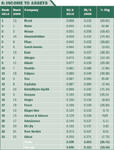
8: Income To Assets
Return on Assets: Return on Assets is one of our three most critical metrics, the other two being Change in Enterprise Value and Enterprise Value to Sales. The reason why Return on Assets is so important is that it combines the two basic ways to make money: Margin Management and Asset Management. When you multiply Profit to Sales (P/S) by Sales to Assets (S/A) you get Profit to Assets (P/A). Most people simply fall back in desperation to Profit to Sales: Double sales! ... Cut my expenses in half! ... If your sales are in the $30 billion-plus range, it will be difficult to double sales any time soon. If you are merging and acquiring and simply firing/laying off people and closing plants, there is no one left to fire except the executives at the top with their inflated golden parachutes. But when you combine the dozens of line items on the income statement along with the line items on the balance sheet, you don't need to dramatically change one statement or the other; indeed, substantial changes in performance can be achieved with relatively minor changes to each line item. When Sales to Assets is multiplied by Profit to Assets, Profit to Assets reflects a much more meaningful measure of performance.
Strong Management Counts
To that point, we see the following leaders in the Dr. Bill Trombetta Hall of Fame, which cites those companies that, over time, have tended to excel in managing assets as well as margins:

Sales to Employee: This is another metric that reflects productivity and efficiency. As with Sales to Assets, the company that can do more with less, or is more productive and efficient with the same level of assets, performs better than its peers. The average Sales to Employee ratio for 2010 was: $629,316. That is, each employee of every company in our lineup produced, on average, $629,316 in revenues. The higher the ratio, the more productive and efficient the firm is; the lower the ratio is an indication that the firm is overstaffed and/or it needs to increase its sales given its work force.
As per all our former audits, we see that the biotechs are at another level in terms of sales force productivity. Thanks to high drug prices, lower-sized sales forces, and more targeted markets, sales for biotechs need relatively fewer employees. Setting a torrid pace is Gilead with close to $2 million in sales per employee.
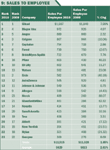
9: Sales To Employee
SG&A to Sales: The final metric is Sales, General and Administrative Expenses (SG&A) to Sales. We do not weight this metric because it may be a temporary year-to-year situation where a company introduces or launches a new drug or needs to train a new sales force. But over time, it is important that growth in SG& A does not exceed sales growth. Another term for SG&A is overhead, or burden. This metric appears on a firm's profit and loss statement or income statement. So it is an operating expense that includes marketing and sales spend but substantially more items than just sales and marketing. SG&A includes all expenses necessary to run the business on a day-to-day basis, including leasing, legal, and accounting fees, utilities, rent, etc. Sales and marketing spend is a relatively low portion of SG&A.
For the period 2010 – 2009, the average SG&A spend to sales for our lineup is 30.4 percent percent, compared to 28.1 percent, respectively. Sales growth averaged about 11 percent, with growth in SGA averaging 8.2 percent. So the pattern for 2010 moved in the right direction. But there are situations that call for comment. Noteworthy are the biotechs such as Gilead and Biogen-Idec that have relatively little need to spend on marketing and promotion. It is not clear why GSK's numbers are so far out of line, at 45 percent, for 2010; with sales growth negative for the period, the 36 percent in SG&A is counterintuitive. This may be associated with hybrid firms that offer more than just pharmaceuticals. For example, Allergan's cosmetic franchise relying on out-of-pocket spend seems to line up with more of a need to market. Again, this metric does not merit weighting as a force associated with successful performance. But as drug companies see restraints on sales growth and the ability to raise price, the ability to control SG&A will affect performance. This is certainly a judgment that Wall Street is prepared to make, as the perception is that Big Pharma in particular has only begun to get its expenses in line with the new market realities imposed by price competition and patent expires.
AND THE WINNER IS ... NOVO NORDISK
Novo Nordisk ranked in the top five for each of our eight key metrics. Without a significant merger or acquisition, Novo Nordisk posted a 33 percent increase in shareholder value. In an increasingly hostile environment for pricing, Novo Nordisk was able to increase Gross Margin over 7 percent from 2009. It registered the second-highest Enterprise Value to Sales ratio, with an increase in this most important metric from 2009. Novo Nordisk came in fifth in profitability to sales and first in asset management, resulting in second place on the Return on Asset metric.
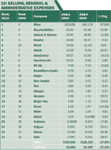
10: Selling, General & Administrative Expenses
A TEN-YEAR PERSPECTIVE
Going back to September 2002, when we published the first Pharmaceutical Industry Audit, the bellweather metric was creation of shareholder value, followed by Enterprise Value to Sales.

Increase in Enterprise Value
Using FactSet's database, Enterprise Value for each firm above was calculated from Dec. 31, 2002, through Dec. 31, 2010. Celgene comes in with the largest 10-year increase in Enterprise Value, at approximately 1,166 percent. At Dec. 31, 2001, Celgene's EV was $2.1 billion; by Dec. 31, 2010, Celgene's EV hit $26.6 billion, an increase of $24.5 billion from the end of 2001. At the other end, Lilly saw EV drop by 52 percent. Most of the major pharmas tracked the macro numbers posted below.

11: SG&A to Sales
To put this in perspective, the changes over the last 10 years in the major indexes were:

THE FINISHING TOUCHES
A useful corrective, this year's Industry Audit also demonstrates that big acquisitions aren't necessarily the path toward a stronger, more innovative organization, and it gives credence to the view that specialization—as opposed to broad therapeutic and portfolio diversification—is one way to weather a stormy economy. The top four companies in the rankings all received a vast majority of revenues from within a single disease area: Novo Nordisk with diabetes; Biogen Idec with multiple sclerosis; Gilead with AIDS; and Celgene with cancer treatments. That doesn't mean diversification isn't a way forward, but it does mean that that it's not the only way. The next couple of years will be trying for industry, as all eyes turn to innovation coming out of the pipeline, but those firms capable of leveraging their assets, and squeezing every bit of value out of every resource—and every administrative dollar on costs—will be rewarded through improved reputation, new investment, and grateful shareholders.

And the Winner Is...

Regeneron, Roche Launch Major US Expansion Plans to Meet Growing Demand for Biologics and Innovation
April 22nd 2025With combined investments exceeding $53 billion, both companies are deepening their US presence through expanded biologics production, gene therapy capabilities, and next generation R&D centers.